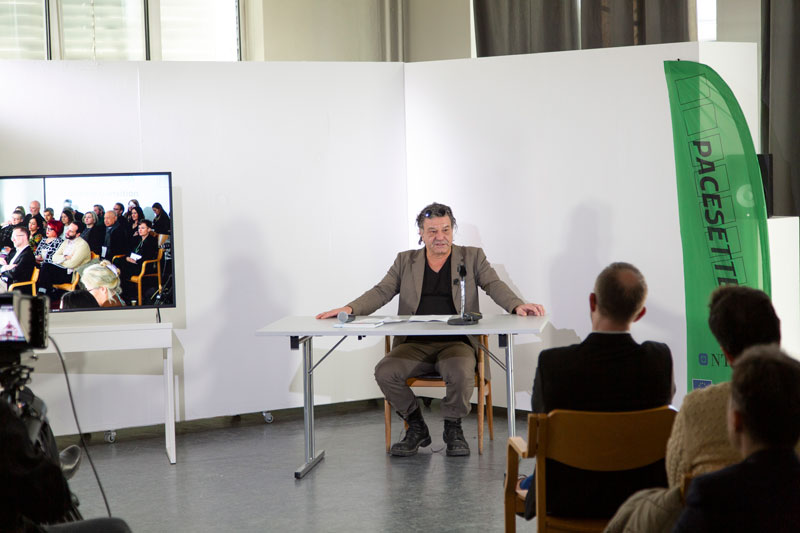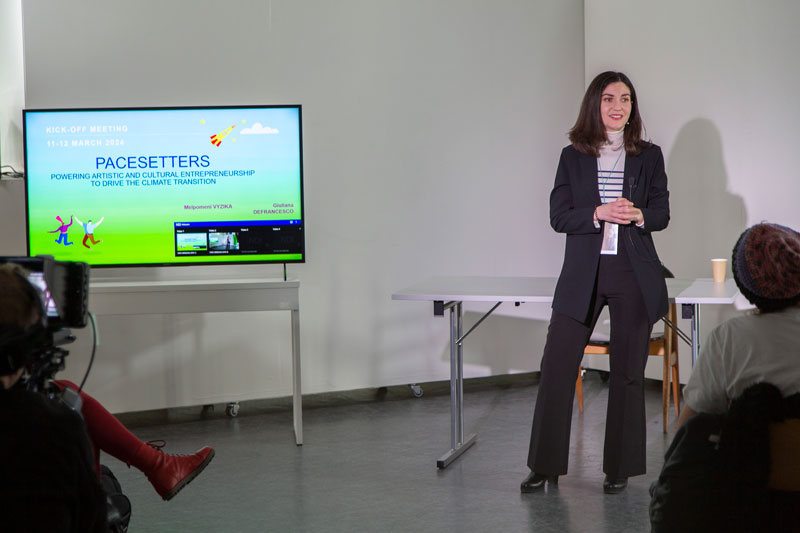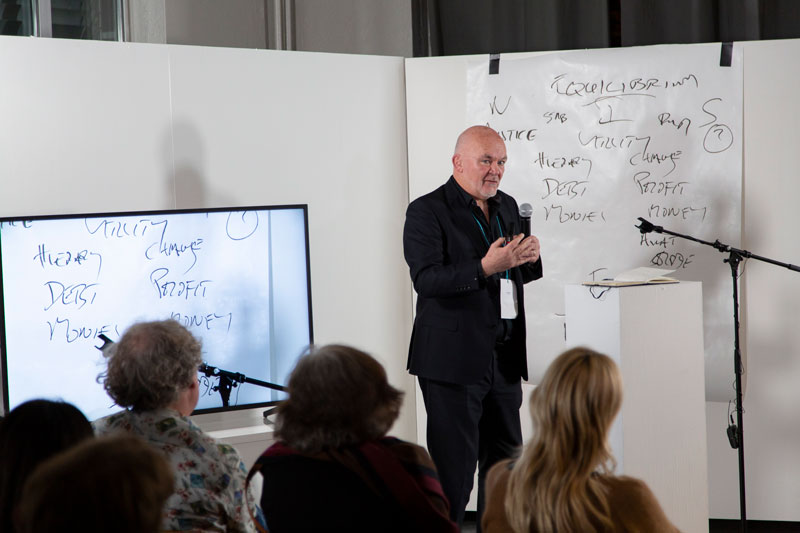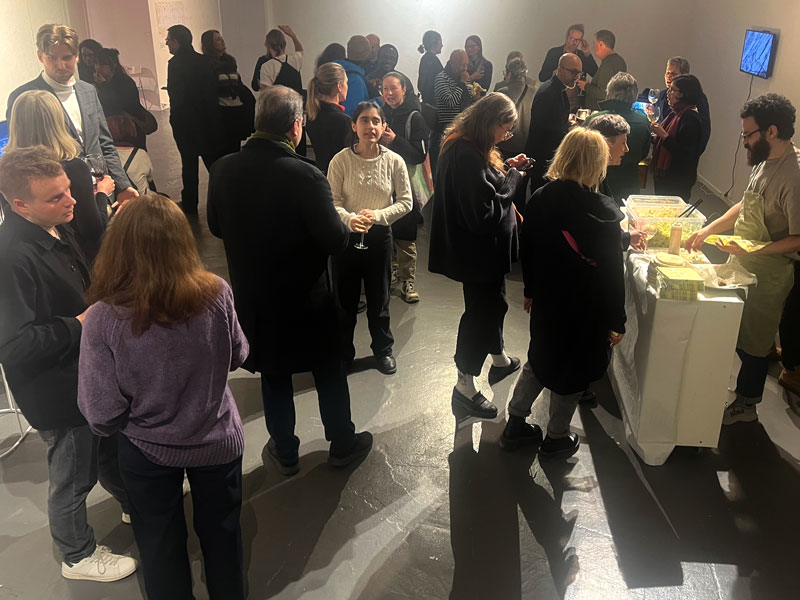Toril A Nagelhus Hernes, Pro-Rector for Innovation, welcomed the participants to the Norwegian University of Science and Technology: "As a research university, NTNU is focused on science and technology. However, NTNU's eight faculties cover the full range of cultural sectors and creative industries: From architecture to music, from design to literature, from theatre to digital filmmaking".
It was a stroke of good fortune to schedule the official PACESETTERS kick-off meeting on two days when the city of Trondheim was basking in sunshine and crisp air. 40 representatives from all 15 consortium partners gathered on 11 and 12 March 2024 at the Norwegian University of Science and Technology to officially launch a new three-year research and innovation action funded by the EU's Horizon Europe research programme.
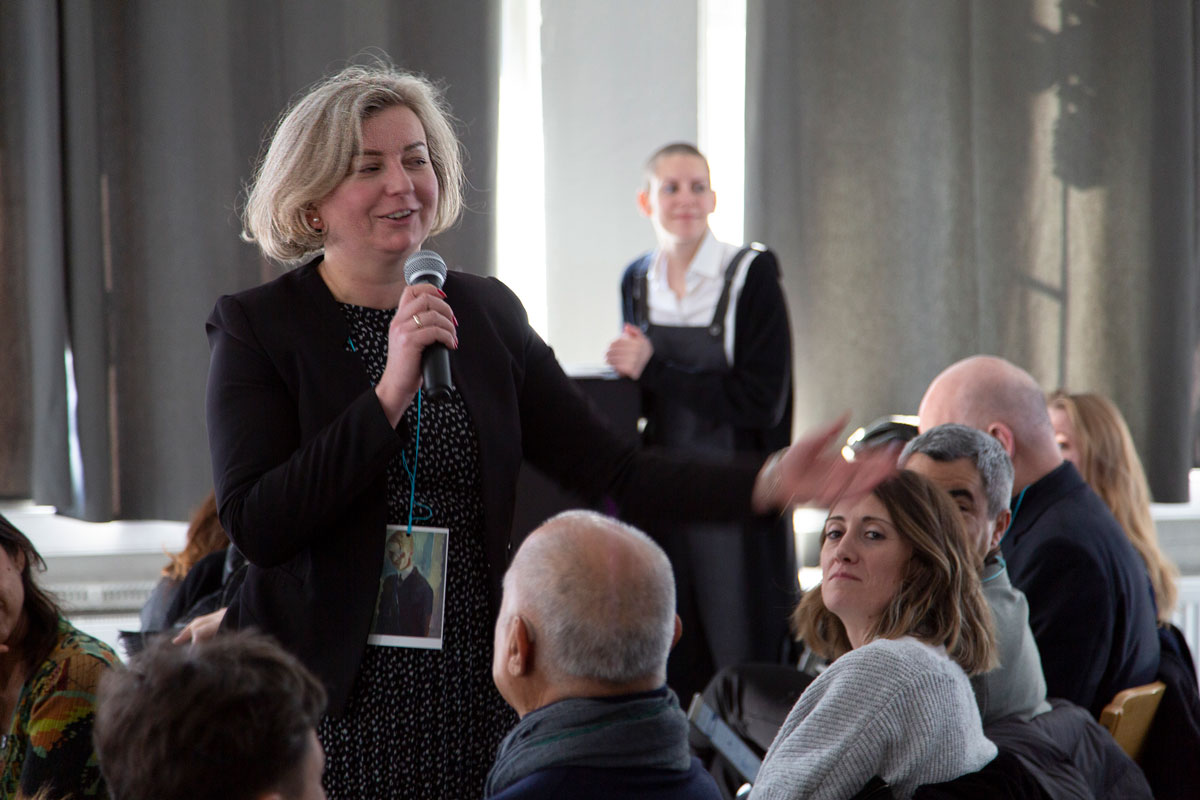
Marta Materska-Samek from the Jagiellonian University in Krakow introduces the
three Real World Laboratories at PACESETTERS Kick-off Meeting in Trondheim
Florian Schneider presents the PACESETTERS research project. Photo: Bruce Sampson/NTNU
She highlighted the fact that NTNU is one of the few technical universities in the world to include an art academy. Since 2017, artistic research has also been one of the four pillars of NTNU's strategy, as Eli Støa, vice-dean for research at the Faculty of Architecture and Design, pointed out. Artistic research refers to a form of knowledge production that is becoming increasingly important: knowledge that is produced through the special means of art and culture, rather than about them.
But what does that mean in practice? Florian Schneider, project coordinator of PACESETTERS, tried to clear up a common misunderstanding: PACESETTERS is not about making art about climate change, even if it looks like contemporary art. Instead, PACESETTERS will take a different route:
"We want to explore how the particular skills, advanced competencies and privileges of artists and creatives can best be invested to advance social change and drive current transitions."
In sport, a PACESETTER is a runner who leads the first part of a middle or long distance race to ensure high speed and avoid excessive tactical racing.
Florian Schneider says: "This is exactly why we are here and why we have gathered for this event, to launch not just another EU project addressing climate change issues. We truly believe, we are deeply convinced and we have an unshakable faith that art and culture, heritage and creativity can make a difference here and now".
Over the two days of the kick-off meeting, participants from nine European countries discussed in plenary sessions and small working groups how to translate the high ambitions of the proposal into practice that is diverse, creative and, most importantly: off the beaten track.
The three PACESETTERS Real World Laboratories are located on the fringes of the European Union and on the edge of conventional notions of innovation: Genalguacil, a small town in the extreme south of Spain, where climate disruption is having catastrophic effects and the local community is developing creative strategies to combat it by activating art and culture.
The future of major events is at stake at the Galway International Arts Festival, which attracts more than 400,000 visitors to the west coast of Ireland each year. And the cultural centre of Nowa Huta, a former steelworks district on the outskirts of Krakow, Poland, is grappling with the challenges of a legacy of utopian social-realist urban planning and the arrival of tens of thousands of Ukrainian refugees.
Giuliana De Francesco, Policy Officer at the European Commission, outlined the growing importance of culture and creativity in EU policies. Starting with the 2007 "European Agenda for Culture in a Globalising World" and leading to a Cluster devoted to Culture, creativity and inclusive society by the Framework Programme for Research and Innovation Horizon Europe (2021-2027).
Melpomeni Vyzika, PACESETTERS project officer at the EU's Research Executive Agency. Photo: Bruce Sampson/NTNU
Melpomeni Vyzika, PACESETTERS project officer at the EU's Research Executive Agency, introduced the requirements, challenges and opportunities of managing a research project of this scale, before task and work package leaders gave a guided tour through the implementation plan.
PACESETTERS will begin by mapping the challenges of the climate transition for cultural and creative sectors and industries. This map will inform a series of 12 creative case studies organised around the main themes of the research: Decentralised Architectures, Collective Intelligences and Shared Creativity. These case studies will be carried out by cross-disciplinary collaborative research teams to explore the specific innovation potential within and across a highly fragmented sector still characterised by silo thinking and solo-acting.
Rather than producing reports that end up on a shelf, PACESETTERS will engage academics and artists, business angels and industry experts, creatives and practitioners from a range of fields in these case studies. An open call for advanced practices will be launched in April to gather input on the full range of case studies, from 'Digital knitting as a counter-concept to fast fashion' to 'Documentary theatre and post-dramatic strategies to monitor progress towards climate neutrality', from 'Circular aesthetics of new materials in artificial biology systems' to 'Reverse engineering data visualisation'.
The results of these case studies will be implemented and tested in PACESETTERS' three real-world laboratories, before forming the basis for evaluation and support frameworks, as key outcomes of the research processes.
In mid-2025, PACESETTERS is planning a major event. The Creative Transformation Summit will present and discuss the first results of the project. This event will be complemented by Local Impact Academies that will engage local ecosystems in culture and creativity.
James Livesey presents the concept of Transitions. Photo: Bruce Sampson/NTNU
On the evening of the first day of the Kick-off Meeting, the doors were opened to the public. More than 200 online and offline visitors attended a session in which ten project participants and invited guests gave seven-minute presentations on a first selection of key terms and concepts for driving the climate transition.
Contributors included Annela Anger-Kraavi, project leader of the Climate Change Policy Group at the University of Cambridge who chose 'Justice' as a key concept for the climate transition. James Livesey, Vice-President Research and Innovation at the University of Galway, clarified the concept of 'Transition' from both a historical and contemporary perspective. Among the ten concepts presented in this first edition of the video lexicon was also 'Repair' by Denis Jaromil Roio and 'Refraction', introduced by Joost Raessens, coordinator of the PACESETTERS sister project "Strategies", funded under the same call.
Research practices in and through the arts and culture will require new terminologies and the reappropriation of existing concepts, say Florian Schneider and Mari Sanden in their introduction to the public event. However, artistic responses to societal challenges should not reduce the complexity at stake to oversimplified messages. This is particularly important in cross-disciplinary collaborations that draw on expertise and experience from different fields of knowledge.
We will turn the fragmentation of the cultural and creative industries from a weakness into a strength: This means reframing the challenges of climate change as opportunities for artists and creatives to contribute to just transitions.
Earlier in the day, the General Assembly of the PACESETTERS project partners appointed an External Expert Advisory Board, bringing together the expertise and experience of scientific, political and cultural leaders: Diana Urge-Vorsatz is Professor at the Department of Environmental Sciences and Policy at the Central European University (CEU) and has been elected Vice-Chair of the Intergovernmental Panel on Climate Change in July 2023. Bernd Fesel is CEO of the EIT Culture & Creativity. Anna Pięta is a committed advocate for social and environmental causes and a sustainability enthusiast in the fashion industry. Paul Watkinson chaired the UNFCCC Subsidiary Body for Scientific and Technological Advice (SBSTA) and served as Senior Advisor to the Chief Executive Officer of COP28 UAE in 2023. Marilyn Gaughan Reddan is Chief Executive of the Galway Culture Company.
Participants of the kick-off meeting mingle over falafel prepared and presented by Ali al-Jabali and drinks with students and doctoral candidates from NTNU's Art Academy.
The PACESETTERS kick-off meeting ended with a party organised by master students and PhD candidates from the Trondheim Academy of Fine Art. Among the works presented in a pop-up exhibition at the Academy's gallery were a live-streamed performance by UKRAiNATV featuring Nasrin Ebrahim Khari supported by Giula Timis and music by Unnur Andrea Einarsdottir as well as a "Theremin Tapestry" designed by Chicks on Speed and woven by Amy Cornall & Milly Formby.
Hilde Stiegler Rubecksen explored 'Man-made Adaptations to Wool in the Anthropocene' and Anneli Røros, financial advisor at the Art Academy, turned wool scraps into hand-knitted purses. Mari Basteshevski mapped 'Pending Xenophora' onto the wall, while Temitayo Ogunbiyi and Ayodele Arigbabu presented their video game 'You will flow'. 'La Huerta: Field Notes', a video by Prerna Bishnoi and Gustav Gunvaldsen, is the result of a most recent collaboration with Nerea Holgado and Álvaro Holgado Sánchez from Genalguacil -- one of the three PACESETTERS Real World Laboratories.

